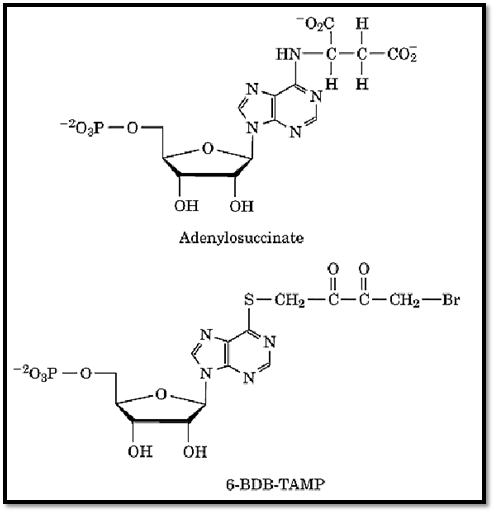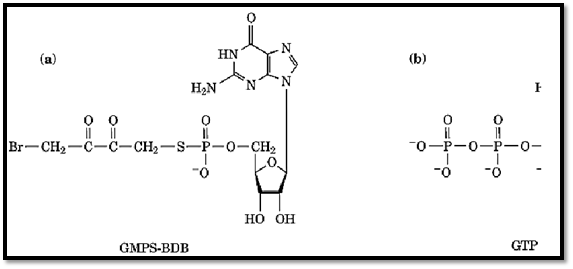


 النبات
النبات
 الحيوان
الحيوان
 الأحياء المجهرية
الأحياء المجهرية
 علم الأمراض
علم الأمراض
 التقانة الإحيائية
التقانة الإحيائية
 التقنية الحيوية المكروبية
التقنية الحيوية المكروبية
 التقنية الحياتية النانوية
التقنية الحياتية النانوية
 علم الأجنة
علم الأجنة
 الأحياء الجزيئي
الأحياء الجزيئي
 علم وظائف الأعضاء
علم وظائف الأعضاء
 الغدد
الغدد
 المضادات الحيوية
المضادات الحيوية|
Read More
Date: 31-12-2015
Date: 1-12-2015
Date: 20-5-2021
|
Affinity Labeling
Affinity labeling is a strategy to modify chemically an amino acid residue within a specific ligand-binding site of an enzyme, either at the active site or at a regulatory, allosteric site. In this approach, a reagent is designed that resembles structurally the natural ligand of the enzyme but features in addition a functional group capable of reacting covalently and indiscriminately with many different amino acid residues. The designed reagent is intended to mimic the natural ligand in forming a reversible enzyme-reagent complex analogous to the enzyme-substrate complex and, once directed to that specific site, to react irreversibly with an amino acid residue accessible from that site. In the case of a purified enzyme, such a reagent allows identification of a particular ligand binding site or domain, which can be an experimental evaluation of a predicted binding site location based on recognition of a protein motif from its amino acid sequence. Affinity labeling constitutes a valuable starting point for selecting appropriate target sites for subsequent site-directed mutagenesis experiments and is an important tool in probing structure–function relationships in enzymes. If the synthesized reagent has a characteristic absorbance or fluorescence spectrum, affinity labeling offers a means of introducing a chromophore at a specific substrate site to report on the enzyme conformation or on distances between designated sites in the enzyme. For medicinal chemistry, affinity labeling permits mapping of the substrate binding site and establishment of its size, so that inhibitory drugs directed toward that site can be designed more rationally. In the case of a heterogeneous cell preparation or of a complex protein mixture, a specific affinity label can be used to identify a receptor protein or to tag a class of macromolecules, such as nucleotide binding proteins.
One characteristic of affinity labeling is the initial formation of a reversible enzyme–reagent complex (ER), as indicated below.

where E and R represent the free enzyme and reagent, respectively, and ER′ is the covalently modified enzyme. The formation of a reversible ER complex is often indicated by a “rate saturation effect” in which the rate constant for modification (kobs) increases as the reagent concentration is elevated until the enzyme site is saturated with reagent; subsequently, the rate constant (kmax) is not changed by further increases in reagent concentration (see Kinetics). This kinetic pattern contrasts with the linear dependence on reagent concentration of the rate of a direct bimolecular chemical modification. For an affinity label, kobs can be described by the equation

where the apparent dissociation constant for the enzyme–reagent complex KR, is given by (k-1+ kmax)/k1 and where kmax is the maximum rate of modification at saturating concentrations of reagent. This type of kinetic behavior is often presented as a double reciprocal plot of 1/kobs versus 1/[R], based on the equation

Examples of purine nucleotide-based affinity labels are shown in Figures 1 and 2. Experiences with their use illustrate the possibilities of affinity labeling.

Figure 1. Comparison of the structures of the natural ligand adenylosuccinate and of the affinity label 6-(4-bromo-2,3-di 5′-monophosphate (6-BDB-TAMP).

Figure 2. Comparison of the structures of the affinity label (a) guanosine 5′-0-[S-(4-bromo-2,3- dioxobutyl)thio]phospha (b) the natural ligand GTP.
1. BDB-TAMP
The compound 6-(4-bromo-2,3-dioxobutyl)thioadenosine 5′-monophosphate (6-BDB-TAMP) shown in Figure 1 was synthesized as a reactive nucleotide analogue to target nucleotide binding sites in enzymes (1). The bromoketo group, adjacent to the 6-position of the purine ring, can potentially react with several nucleophiles found in proteins, including those of the side chains of cysteine, histidine, tyrosine, lysine, methionine, glutamate, and aspartate residues. In addition, the dioxo group provides the possibility of reaction with arginine residues.
As shown in Figure 1, the structure of 6-BDB-TAMP also exhibits a remarkable resemblance to that of adenylosuccinate, a key metabolic intermediate in the conversion of inosine monophosphate to adenosine monophosphate. The last step in that pathway is catalyzed by adenylosuccinate lyase, an enzyme proposed to initiate the cleavage reaction to AMP by attack of an enzymic general base on the b hydrogen of adenylosuccinate. Elimination of the amino group is then facilitated by protonation of the leaving group by an enzymic general acid. Despite this proposal, the key general base and acid of the enzyme had not been identified. The similarity between the structures of adenylosuccinate and 6-BDB-TAMP suggested that the latter would bind irreversibly to the adenylosuccinate site of adenylosuccinate lyase, where the bromodioxobutyl group would be likely to occupy the succinyl subsite at which the critical catalytic steps should occur.
6-BDB-TAMP has recently been confirmed to function as an affinity label of Bacillus subtilis adenylosuccinate lyase (2). The initial inactivation rate constant exhibits nonlinear dependence on the concentration of 6-BDB-TAMP, with an apparent reversible KR = 30 µM prior to irreversible inactivation at pH 7.0 and 25°C. The tetrameric enzyme incorporates about 1 mol of 6-BDB-[32P] TAMP per mol of enzyme subunit on complete inactivation. The substrate adenylosuccinate or the products AMP plus fumarate protect against inactivation and incorporation of radioactive reagent, indicating that 6-BDB-TAMP targets the adenylosuccinate binding site. Purification of the only radioactive peptide labeled by 6-BDB-TAMP led to the identification of His141 as the modified amino acid (2). These results indicated that 6-BDB-TAMP is an affinity label of His141 in the substrate binding site of adenylosuccinate lyase, where it may serve as a general base accepting a proton from the succinyl group during catalysis (2) (see Histidine )His, H) residues). This study illustrates many of the desirable characteristics of affinity labeling: binding of the reagent by the enzyme prior to modification of a single site under mild conditions, competition between the reagent and the natural ligand (adenylosuccinate), and identification of the modified residue within a protein of known amino acid sequence.
2. GMPS-BDB
A reactive guanine derivative is shown in Figure 2, guanosine 5′-0-[S-4-bromo-2,3-dioxobutylthio] phosphate (GMPS-BDB), which represents a novel class of compounds containing a bromodioxobutyl group linked to the sulfur of a purine nucleotide thiophosphate (3, 4). The reactive moiety of GMPS-BDB is located at a position equivalent to that of the pyrophosphate region of GTP, as illustrated in Figure 2. Thus, it might be expected that GMPS-BDB would act as an affinity label for GTP sites in proteins (see GTP-Binding Proteins).
Adenylosuccinate synthetase catalyzes the first of the two enzymatic reactions in the conversion of IMP: the condensation of IMP and aspartate to form adenylosuccinate, as GTP is hydrolyzed to GDP and inorganic phosphate. The phosphoryl group has been proposed to be transferred to IMP from the terminal phosphate of GTP to form a 6-phosphoryl-IMP intermediate.
GMPS-BDB has been used as an affinity label of adenylosuccinate synthetase from Escherichia coli, and it has been demonstrated that inactivation occurs concomitantly with the modification of Arg143 of each subunit of the dimeric enzyme (5). The modification of Arg143 and the inactivation by GMPS-BDB is prevented by adenylosuccinate or by IMP plus GTP, implying that the reaction target is in the region of the active site. This result pointed to Arg143 as a logical target for site-directed mutagenesis; when the positively charged arginine was replaced by the neutral leucine, the expressed mutant enzyme exhibited a significant decrease in its affinity for nucleotides (5.(
The crystal structure of E. coli adenylosuccinate synthetase has been determined, allowing a comparison to be made between the substrate sites identified by affinity labeling of the enzyme in solution and those assigned within the crystalline form by X-ray crystallography. Arg143 from one subunit projects into the putative active site of the second subunit, indicating that both subunits of dimeric adenylosuccinate synthetase contribute to each active site and that Arg143 plays an important role in nucleotide binding.
3. AMPS-BDB
The adenosine analogue of GMPS-BDB has also been synthesized: adenosine 5′-0-[S-(4-bromo-2,3-dioxobutyl)thiophosphate] (AMPS-BDB) (4) and can be considered as a reasonable mimic of ADP or ATP. Bovine liver glutamate dehydrogenase is an allosteric enzyme that is reversibly activated by ADP. On incubation of AMPS-BDB with glutamate dehydrogenase, the enzyme reacts covalently, resulting in an irreversibly activated enzyme that is no longer responsive to externally added ADP (6). AMPS-BDB appears to function as an ADP substitute that is covalently bound to Arg459 within the activator site of the allosteric bovine liver glutamate dehydrogenase (6).
The above are representative examples of enzymes that have been studied using the strategy of affinity labeling. They illustrate how affinity labeling, X-ray crystallography and site-directed mutagenesis can be used as complementary approaches in evaluating the functional role of particular amino acids in a protein.
References
1. R. F. Colman, Y.-C. Huang, M. M. King, and M. Erb (1984) Biochemistry 23, 3281–3286.
2 .T. T. Lee, C. Worby, J. E. Dixon, and R. F. Colman (1997) J. Biol. Chem. 272, 458–465.
3. D. H. Ozturk, I. Park, and R. F. Colman (1992) Biochemistry 31, 10544–10555.
4. S. H. Vollmer, M. B. Walner, K. V. Tarbell, and R. F. Colman (1994) J. Biol. Chem. 2698082–8090, .
5. O. A. Moe et al. (1996) Biochemistry 35, 9024–9033.
6. K. O. Wrzeszczynski and R. F. Colman (1994) Biochemistry 33, 11544–11553.



|
|
|
|
صحتك العقلية.. "حقيقة مدهشة" بشأن تأثير العمل
|
|
|
|
|
|
|
هل تنقل سماعات الأذن بياناتك الشخصية؟
|
|
|
|
|
|
قسم الشؤون الفكرية يصدر العدد الثامن والثلاثين من مجلة دراسات استشراقية
|
|
|
|
مجمع أبي الفضل العباس (عليه السلام) يستقبل الطلبة المشاركين في حفل التخرج المركزي
|
|
|
|
جامعة الكفيل تحيي ذكرى هدم مراقد أئمة البقيع (عليهم السلام)
|
|
|
|
الانتهاء من خياطة الأوشحة والأعلام الخاصة بالحفل المركزي لتخرج طلبة الجامعات
|